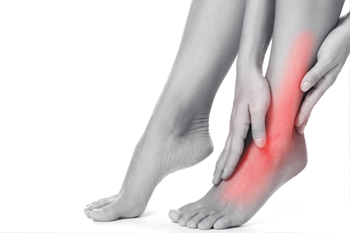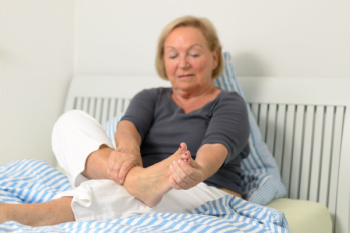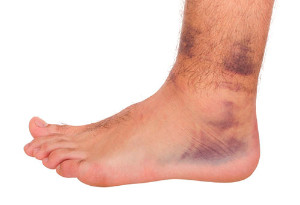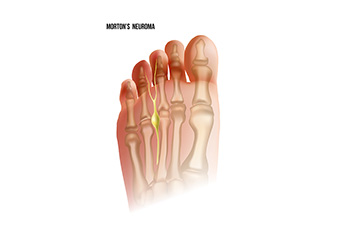Items filtered by date: April 2024
Causes and Treatment of Hammertoe

Hammertoe is a prevalent foot deformity characterized by an abnormal bending of one or more toes, typically the second, third, or fourth toe. This condition develops when the muscles and ligaments surrounding the toe joint become imbalanced, causing the affected toe to bend downward at the middle joint, resembling a hammer. Hammertoe can result from various factors, including genetics, wearing ill-fitting shoes that force the toes into unnatural positions, or foot trauma. Over time, the bent toe may become rigid and inflexible, leading to discomfort, pain, and difficulty while walking or wearing shoes. In some cases, corns or calluses may develop on the tops or tips of the affected toes due to friction and pressure against footwear. While hammertoe can be bothersome, early intervention with proper footwear, toe exercises, splinting, or orthotic devices can help alleviate symptoms and prevent the condition from worsening. Seeking prompt treatment from a podiatrist can ensure effective management of hammertoe and improve foot function and comfort. If you are afflicted with hammertoe, it is suggested that you confer with this type of doctor who can offer you relief and treatment remedies that are right for you.
Hammertoe
Hammertoes can be a painful condition to live with. For more information, contact Priyanka Mude, DPM from North Canton Podiatry. Our doctor will answer any of your foot- and ankle-related questions.
Hammertoe is a foot deformity that affects the joints of the second, third, fourth, or fifth toes of your feet. It is a painful foot condition in which these toes curl and arch up, which can often lead to pain when wearing footwear.
Symptoms
- Pain in the affected toes
- Development of corns or calluses due to friction
- Inflammation
- Redness
- Contracture of the toes
Causes
Genetics – People who are genetically predisposed to hammertoe are often more susceptible
Arthritis – Because arthritis affects the joints in your toes, further deformities stemming from arthritis can occur
Trauma – Direct trauma to the toes could potentially lead to hammertoe
Ill-fitting shoes – Undue pressure on the front of the toes from ill-fitting shoes can potentially lead to the development of hammertoe
Treatment
Orthotics – Custom made inserts can be used to help relieve pressure placed on the toes and therefore relieve some of the pain associated with it
Medications – Oral medications such as anti-inflammatories or NSAIDs could be used to treat the pain and inflammation hammertoes causes. Injections of corticosteroids are also sometimes used
Surgery – In more severe cases where the hammertoes have become more rigid, foot surgery is a potential option
If you have any questions please contact our office located in North Canton, Ohio . We offer the newest diagnostic and treatment technologies for all your foot and ankle needs.
Heel Pain Can Be Treated!
Causes of Foot Pain at Night

Foot pain at night can disrupt your sleep and affect your overall quality of life, leaving you restless and uncomfortable. Understanding the underlying causes is crucial for finding relief and improving your well-being. One common culprit is plantar fasciitis, characterized by inflammation of the tissue connecting the heel to the toes. This condition often leads to sharp, stabbing pain in the heel or arch, particularly when getting out of bed in the morning or after long periods of rest. Another potential cause is neuropathy, a nerve disorder that can result from conditions like diabetes or vitamin deficiencies. Neuropathic pain may present as burning, tingling, or shooting sensations in the feet, worsening at night when lying down. Additionally, arthritis, stress fractures, and overuse injuries can contribute to nocturnal foot pain. Identifying the specific cause through proper diagnosis by a healthcare professional is essential for implementing targeted treatment strategies and finding relief from nighttime foot discomfort. If you have foot pain at night, it is suggested that you make an appointment with a podiatrist for care.
Foot Pain
Foot pain can be extremely painful and debilitating. If you have a foot pain, consult with Priyanka Mude, DPM from North Canton Podiatry. Our doctor will assess your condition and provide you with quality foot and ankle treatment.
Causes
Foot pain is a very broad condition that could be caused by one or more ailments. The most common include:
- Bunions
- Hammertoes
- Plantar Fasciitis
- Bone Spurs
- Corns
- Tarsal Tunnel Syndrome
- Ingrown Toenails
- Arthritis (such as Gout, Rheumatoid, and Osteoarthritis)
- Flat Feet
- Injury (from stress fractures, broken toe, foot, ankle, Achilles tendon ruptures, and sprains)
- And more
Diagnosis
To figure out the cause of foot pain, podiatrists utilize several different methods. This can range from simple visual inspections and sensation tests to X-rays and MRI scans. Prior medical history, family medical history, and any recent physical traumatic events will all be taken into consideration for a proper diagnosis.
Treatment
Treatment depends upon the cause of the foot pain. Whether it is resting, staying off the foot, or having surgery; podiatrists have a number of treatment options available for foot pain.
If you have any questions, please feel free to contact our office located in North Canton, Ohio . We offer the newest diagnostic and treatment technologies for all your foot care needs.
Exploring Gout in the Elderly

Gout, a form of arthritis, presents unique challenges for elderly individuals, necessitating a deeper understanding of its intricacies. Characterized by sudden and severe joint pain, typically in the big toe, gout occurs due to the accumulation of urate crystals in the joints. While gout can affect anyone, its prevalence increases with age, making it a prevalent concern among the elderly population. Various factors contribute to gout development in older adults, including age-related changes in metabolism, chronic health conditions like hypertension and kidney disease, and certain medications commonly prescribed to manage age-related ailments. Dietary habits, particularly rich diets high in purine-containing foods like red meat and seafood, also play a significant role in gout onset and exacerbation. Proper management of gout in the elderly involves a varied approach, encompassing lifestyle modifications, medication adherence, and close monitoring to alleviate symptoms. If you are an elderly person who has had one or more gout attacks, it is suggested that you consult a podiatrist who can help you to manage this condition.
Gout is a foot condition that requires certain treatment and care. If you are seeking treatment, contact Priyanka Mude, DPM from North Canton Podiatry. Our doctor will treat your foot and ankle needs.
What Is Gout?
Gout is a type of arthritis caused by a buildup of uric acid in the bloodstream. It often develops in the foot, especially the big toe area, although it can manifest in other parts of the body as well. Gout can make walking and standing very painful and is especially common in diabetics and the obese.
People typically get gout because of a poor diet. Genetic predisposition is also a factor. The children of parents who have had gout frequently have a chance of developing it themselves.
Gout can easily be identified by redness and inflammation of the big toe and the surrounding areas of the foot. Other symptoms include extreme fatigue, joint pain, and running high fevers. Sometimes corticosteroid drugs can be prescribed to treat gout, but the best way to combat this disease is to get more exercise and eat a better diet.
If you have any questions please feel free to contact our office located in North Canton, Ohio . We offer the newest diagnostic and treatment technologies for all your foot and ankle needs.
Distinguishing Between High and Low Ankle Sprains

Understanding the variance between high and low ankle sprains is vital for accurate diagnosis and appropriate treatment. Low ankle sprains, commonly known as lateral ankle sprains, affect the ligaments on the outside of the ankle and are prevalent in sudden twists or rolls of the foot. Conversely, high ankle sprains, medically termed syndesmotic sprains, occur when the ligaments connecting the tibia and fibula bones above the ankle joint are stretched or torn. While both injuries cause pain, swelling, and difficulty bearing weight, high ankle sprains typically involve pain above the ankle and are associated with a longer recovery period. Moreover, high ankle sprains often result from more forceful rotational movements, such as those seen in sports like football or skiing. If you have sprained your ankle, it is suggested that you confer with a podiatrist who can determine what type of sprain it is, and offer appropriate treatment solutions.
Ankle sprains are common but need immediate attention. If you need your feet checked, contact Priyanka Mude, DPM from North Canton Podiatry. Our doctor can provide the care you need to keep you pain-free and on your feet.
How Does an Ankle Sprain Occur?
Ankle sprains take place when the ligaments in your ankle are torn or stretched beyond their limits. There are multiple ways that the ankle can become injured, including twisting or rolling over onto your ankle, putting undue stress on it, or causing trauma to the ankle itself.
What Are the Symptoms?
- Mild to moderate bruising
- Limited mobility
- Swelling
- Discoloration of the skin (depending on severity)
Preventing a Sprain
- Wearing appropriate shoes for the occasion
- Stretching before exercises and sports
- Knowing your limits
Treatment of a Sprain
Treatment of a sprain depends on the severity. Many times, people are told to rest and remain off their feet completely, while others are given an air cast. If the sprain is very severe, surgery may be required.
If you have suffered an ankle sprain previously, you may want to consider additional support such as a brace and regular exercises to strengthen the ankle.
If you have any questions please feel free to contact our office located in North Canton, Ohio . We offer the newest diagnostic and treatment technologies for all your foot and ankle needs.
The Truth About Morton's Neuroma

Morton's neuroma, a relatively common foot condition, occurs when a nerve between the toes becomes thickened and inflamed. Despite its name, it is not a true neuroma but rather a thickening of tissue surrounding one of the nerves that leads to the toes. This thickening can cause sharp, burning pain in the ball of the foot or between the toes, typically worsened by walking or wearing tight shoes. Although the exact cause remains unclear, factors such as wearing high heels or tight shoes, participating in high-impact activities, or having certain foot deformities may contribute to its development. Interestingly, Morton's neuroma tends to affect women more often than men. Diagnosis typically involves a physical examination and may include imaging tests such as X-rays or MRI scans to rule out other conditions. Early recognition and appropriate management are key to alleviating symptoms and preventing further complications. If you are experiencing pain in this part of your foot. It is suggested that you visit a podiatrist who can offer treatment options that are best for you.
Morton’s neuroma is a very uncomfortable condition to live with. If you think you have Morton’s neuroma, contact Priyanka Mude, DPM of North Canton Podiatry. Our doctor will attend to all of your foot care needs and answer any of your related questions.
Morton’s Neuroma
Morton's neuroma is a painful foot condition that commonly affects the areas between the second and third or third and fourth toe, although other areas of the foot are also susceptible. Morton’s neuroma is caused by an inflamed nerve in the foot that is being squeezed and aggravated by surrounding bones.
What Increases the Chances of Having Morton’s Neuroma?
- Ill-fitting high heels or shoes that add pressure to the toe or foot
- Jogging, running or any sport that involves constant impact to the foot
- Flat feet, bunions, and any other foot deformities
Morton’s neuroma is a very treatable condition. Orthotics and shoe inserts can often be used to alleviate the pain on the forefront of the feet. In more severe cases, corticosteroids can also be prescribed. In order to figure out the best treatment for your neuroma, it’s recommended to seek the care of a podiatrist who can diagnose your condition and provide different treatment options.
If you have any questions, please feel free to contact our office located in North Canton, Ohio . We offer the newest diagnostic and treatment technologies for all your foot care needs.

